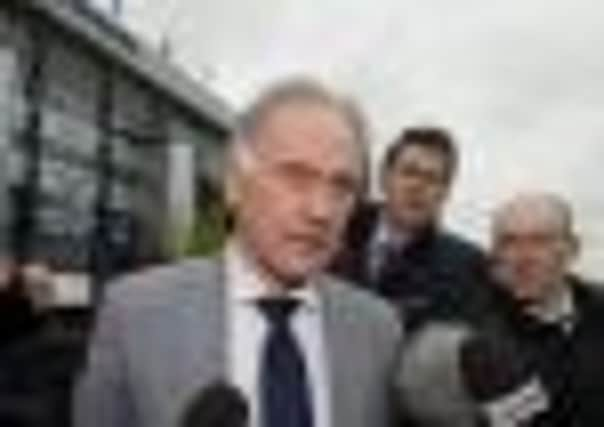Glenn Gibbons: After a life of highlights the best is yet to come


For this veteran chronicler, the occasional discomforts of advancing years are countered by the ever-present awareness of virtually unrelenting good fortune since the beginning. Arriving during the closing months of the second world war, for example, not only ensured avoidance of hostilities that could have been much severer than growing old, but brought a childhood, adolescence and young adulthood that coincided precisely with an authentic golden age in Scottish football.
Born next door to Firhill Stadium, my early years were a constant exposure to capacity crowds, to pennies earned from “Ah watched yer motor, mister” and, most significantly of all, to international-class players from almost every team in the league.
Advertisement
Hide AdAdvertisement
Hide AdPartick Thistle themselves could boast a handful of Scotland players at any given time, with Jimmy Davidson, Johnny Mackenzie, Tommy Ewing, Davie Mathers and Andy Kerr contemporaries.
This proliferation of seriously good players (so widespread that the national team who faced the great Hungarians in 1954 did not contain anyone from Celtic or Rangers) may have been a factor in a phenomenon that is emblematic of its time.
It was the readiness of supporters of every hue to attend the Scottish Cup final, no matter the identities of the combatants.
As a consequence, the 1950s was a decade of such glorious uncertainty that it not only produced seven different winners of the old trophy, but attendances for the finals that nowadays seem astounding.
In 1957, for instance, Falkirk and Kilmarnock drew an aggregate of 163,000 to the first match and the replay, a figure that nowadays would just about equate to an entire season’s home league crowds.
Having made it to the first televised final in 1955, this youngster’s graduation to secondary school the following year brought an unimaginable bonus. It was the possibility of acquiring a cup final ticket, the schools receiving an allocation for Hampden’s capacious schoolboys’ enclosure.
The consequence is a record of having missed only three finals since 1954, all the absences necessitated by unavoidable commitments elsewhere. This means having witnessed all three of Hibs’ appearances in the second half of the 20th century and their solitary final of the first decade of the 21st, as well as Hearts’ six before and one after the millennium.
It is undeniable that, for the great Edinburgh rivals, the event has not always been a pretty experience. An illustrious exception was Hearts’ first of the post-war era, in 1956, when a crowd of 132,840 watched them comprehensively outplay a ragged Celtic.
Advertisement
Hide AdAdvertisement
Hide AdThat was the emergent Tynecastle side of the marvellous Conn-Bauld-Wardhaugh inside-forward trio and the abiding memory of the day was that Hearts should be such hot favourites to win. This they did at a canter, the 3-1 scoreline concealing the detail that, apart from their goal, Celtic did not force the Hearts goalkeeper, Willie Duff, to make a save.
But that exceptional performance was followed two years later by Hibs’ pedestrian resistance to a Clyde team winning the cup for the second time in the decade. It is a measure of the Easter Road side’s general mediocrity in that 1-0 defeat that the highlight should be the illegitimate “goal” scored by the hand of the 17-year-old prodigy, Joe Baker, who had scored all four in the 4-3 elimination of Hearts in the quarter-final.
Since then, there have been Hibs’ 6-1 thrashing by Celtic in 1972 and Hearts’ 5-1 hammering from Rangers in ‘96, although the former took Rangers to three matches in ‘79 and should have won, and the latter exacted revenge from the Ibrox side in ’98.
But, whatever their varying experiences over the past 60 years, this afternoon’s fevered occasion will demonstrate that nothing – but nothing – compares with having them both at Hampden on the same day.
Too many things don’t add up with Charles Green
RANGERS’ prospective new owner, Charles Green, may have been dismayed by the rejection of the Ibrox club’s appeal against punishments deriving from serious misbehaviour, but fans’ scepticism over his future plans are likely to have been more tellingly reinforced by his own “performance” last weekend.
Addressing representatives of supporters’ groups at McDiarmid Park after the St Johnstone match, Green is said to have made revelations that had many in his audience suffering a proliferation of worry lines on their foreheads. A Rangers-supporting friend (himself of substantial means) reports that Green assured his listeners of his good intentions and underlined his bona fides by claiming to have done his “due diligence” over the previous “two or three weeks”.
The sharper tools in the crowd would immediately conclude that, had such scrutiny of the company’s documentation been carried out, something unusual must have occurred to allow someone who was not a preferred bidder to have access. Perhaps the administrators, Dudd...sorry, Duff and Phelps, could enlighten.
Green’s next “sweetener”, it is said, was to tell the congregation that one of the families in his 20-strong consortium had made a £1 billion offer to buy Manchester United. Of course, it had been unsuccessful.
Advertisement
Hide AdAdvertisement
Hide AdSome of the businessmen in the room in Perth are understood to have left the meeting less than buoyed by what they had heard. They wondered why anyone with that amount of money would wish to get involved in a Scottish football club.
They were also said to have been disturbed by the thought that this family of seemingly mountainous resources should be so keen to “invest” a paltry £425,000 – that is, one 20th of the £8.5 million offer – in Rangers. This (admittedly baffled) observer would have another question: why would anyone with £1bn to offload – that’s one thousand million pounds – try to buy any football club anywhere?